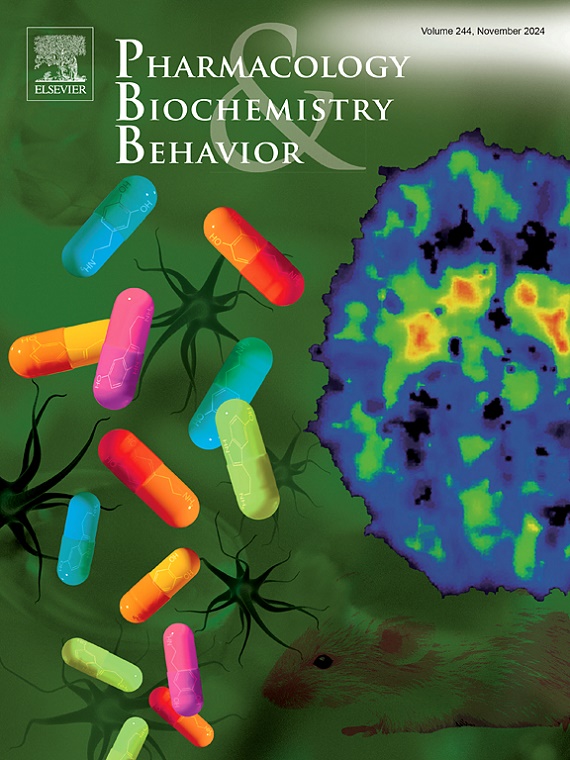Developmental 17-OHPC exposure disrupts behavior regulated by the mesocorticolimbic dopaminergic system in rats
IF 3.3
3区 心理学
Q1 BEHAVIORAL SCIENCES
引用次数: 0
Abstract
The synthetic progestin, 17α-hydroxyprogesterone caproate (17-OHPC), is administered to pregnant individuals with the intention of reducing preterm birth. Although there is evidence that 17-OHPC is likely transferred from mother to fetus, there is little information regarding the potential effects of 17-OHPC administration on behavioral and neural development in offspring. Neonatal 17-OHPC exposure disrupts the development of the mesocorticolimbic dopaminergic pathway and associated behaviors in rats. 17-OHPC exposure altered dopaminergic innervation of prelimbic medial prefrontal cortex (mPFC) in neonates and adolescents and altered performance in measures of decision-making, set-shifting, and reversal-learning tasks. The present study tested the effects of developmental 17-OHPC exposure on numerous cognitive behaviors mediated by the mesocorticolimbic dopaminergic system, such as decision-making in a delay discounting task, latent inhibition following conditioned taste aversion (CTA), and spatial memory in the Morris Water Maze (MWM). The present work also aimed to further investigate response omissions in rats exposed to 17-OHPC during development and the potential role of dopamine D2 receptor in altering omissions in a delay discounting task. 17-OHPC exposure rendered rats less sensitive to an Eticlopride-induced increase in omissions in a delay discounting task when compared to controls. Quinpirole flattened the discount curve in both groups but did not significantly affect omissions in 17-OHPC-exposed or control rats. Following CTA, sucrose-pre-exposed 17-OHPC-exposed rats demonstrated decreased latent inhibition when compared to controls. In Morris Water Maze testing, 17-OHPC-exposed rats did not differ from controls after the first day of testing or during probe testing. These results suggest that exposure to 17-OHPC altered aspects of decision-making and latent inhibition in adult male rats, without affecting performance in a measure of spatial learning and memory. Further, the insensitivity of 17-OHPC-exposed males to an Eticlopride-induced increase in omissions suggests a dysfunction in the D2 receptor following exposure to this clinically used synthetic progestin.
发育期接触 17-OHPC 会破坏大鼠由中皮质边缘多巴胺能系统调控的行为。
孕妇服用合成孕激素--17α-羟基己酸孕酮(17-OHPC)的目的是减少早产。虽然有证据表明 17-OHPC 很可能会从母体转移给胎儿,但有关服用 17-OHPC 对后代行为和神经发育的潜在影响的信息却很少。新生儿接触 17-OHPC 会破坏大鼠皮质中层多巴胺能通路的发育和相关行为。暴露于 17-OHPC 会改变新生儿和青少年边缘前内侧前额叶皮层(mPFC)的多巴胺能神经支配,并改变决策、集合转移和逆转学习任务的表现。本研究测试了发育期暴露于 17-OHPC 对由中皮质边缘多巴胺能系统介导的多种认知行为的影响,如延迟折现任务中的决策、条件性味觉厌恶(CTA)后的潜在抑制以及莫里斯水迷宫(MWM)中的空间记忆。本研究还旨在进一步研究在发育过程中暴露于 17-OHPC 的大鼠的反应遗漏,以及多巴胺 D2 受体在改变延迟折现任务中的遗漏中的潜在作用。与对照组相比,暴露于 17-OHPC 的大鼠在延迟折现任务中对 Eticlopride 诱导的遗漏增加不那么敏感。喹吡罗使两组大鼠的折现曲线趋于平缓,但对暴露于 17-OHPC 的大鼠或对照组大鼠的遗漏没有显著影响。与对照组相比,在进行 CTA 后,蔗糖预暴露的 17-OHPC 暴露大鼠的潜伏抑制能力下降。在莫里斯水迷宫测试中,暴露于 17-OHPC 的大鼠在第一天测试后或探针测试期间与对照组大鼠没有差异。这些结果表明,暴露于 17-OHPC 会改变成年雄性大鼠决策和潜伏抑制的各个方面,但不会影响空间学习和记忆测量的表现。此外,暴露于 17-OHPC 的雄性大鼠对艾司氯必利诱导的遗漏增加不敏感,这表明暴露于这种临床使用的合成孕激素后,D2 受体会出现功能障碍。
本文章由计算机程序翻译,如有差异,请以英文原文为准。
求助全文
约1分钟内获得全文
求助全文
来源期刊
CiteScore
6.40
自引率
2.80%
发文量
122
审稿时长
38 days
期刊介绍:
Pharmacology Biochemistry & Behavior publishes original reports in the areas of pharmacology and biochemistry in which the primary emphasis and theoretical context are behavioral. Contributions may involve clinical, preclinical, or basic research. Purely biochemical or toxicology studies will not be published. Papers describing the behavioral effects of novel drugs in models of psychiatric, neurological and cognitive disorders, and central pain must include a positive control unless the paper is on a disease where such a drug is not available yet. Papers focusing on physiological processes (e.g., peripheral pain mechanisms, body temperature regulation, seizure activity) are not accepted as we would like to retain the focus of Pharmacology Biochemistry & Behavior on behavior and its interaction with the biochemistry and neurochemistry of the central nervous system. Papers describing the effects of plant materials are generally not considered, unless the active ingredients are studied, the extraction method is well described, the doses tested are known, and clear and definite experimental evidence on the mechanism of action of the active ingredients is provided.

 求助内容:
求助内容: 应助结果提醒方式:
应助结果提醒方式:


